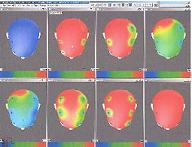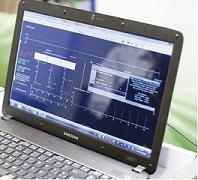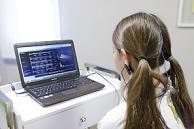Contenido
El trastorno de Deficit de Atención con o sin Hiperactividad (TDAH)
Entre el 70% y 90% de los casos de TDAH presentan un patrón de características electroencefalográficas comunes a todos ellos, una menor actividad cortical en zonas frontales y centrales medias del cerebro. Es decir, presentan una proporción elevada de ondas theta y una proporción reducida de ondas alfa y beta y por tanto una elevada ratio theta/alfa y theta/beta.
Este patrón quiere decir que estos niños/as o jovenes presentan un incremento de actividad o de excitación y en cambio presentan una disminución del estado de focalización/concentración, calma o relajación lo que se traduce en falta de atención, impulsividad o hiperactividad.
Por medio del entrenamiento cerebral con Neurofeedback el niño/a o joven puede cambiar su patrón de ondas cerebrales . Se le entrena en controlar las funciones sobre las que normalmente no tiene un control consciente como la focalización de la atención, la planificación, la consecución de objetivos en función de refuerzos, el autocontrol.

Protocolo de tratamiento del Programa de Neurofeedback y TDAH
- Es imprescindible comprobar el diagnóstico de TDAH y descartar falsos positivos.
Nuestro equipo multidisciplinar: psiquiatras, psicólogas, neuropsicólogas, y pediatra realiza un protocolo de pruebas y consultas para el diagnóstico del TDAH.
En el caso de que venga diagnosticado por otro centro/profesional se revisará la información sobre el diagnostico para corroborar o confirmar el mismo o sugerir la necesidad de realizar pruebas adicionales.
- En todos los casos, diagnosticados previamente o no se realiza el perfil de neurofeedback del paciente para determinar el estado cerebral.
- En base al perfil de neurofeedback se establecerá el tratamiento personalizado

Cómo se cambia el patrón de ondas cerebrales
Tanto para la realización del perfil como para las sesiones de entrenamiento se le coloca un sensor al paciente en el cuero cabelludo y en cada uno de los lóbulos de la oreja. Estos sensores recogen información sobre la actividad eléctrica de su cerebro en tiempo real y lo traslada a un software que traslada esta información en forma visual y auditiva.

El paciente tiene que realizar una serie de ejercicios similares a los de un videojuego con su mente (sin teclado, ratón,…) y cada vez que va logrando el patrón de ondas objetivo va avanzando en el juego y recibiendo recompensas auditivas. Es decir el juego le va informando de los logros que va alcanzando.
El entrenamiento es gradual por lo que es imprescindible completar el tratamiento para generar el cambio deseado.
Características del Neurofeedback
- Esta técnica se puede combinar con otros tratamientos: farmacológicos, psicoterapia,….
- Técnica no invasiva (no se producen estímulos eléctricos, ni se utilizan agujas).
- No produce efectos secundarios.
- La evolución del tratamiento es medible cuantitativamente y con datos objetivos.
- Esta técnica incorpora la última tecnología en información cerebral.

Evidencia científica
La Asociación Americana de Pediatría (AAP) en su informe anual sobre la evidencia científica de los tratamientos para el TDAH coloca al biofeedback/neurofeedback en el level 1 de eficacia. Ver Documento
Actualmente existen más de 100 estudios científicos que avalan la eficacia del Neurofeedback:
Albert, A. O., Andrasik, F., Moore, J. L., & Dunn, B. R. (1998). Theta/beta training for attention, concentration and memory improvement in the geriatric population. Applied Psychophysiology & Biofeedback, 23(2), 109. Abstract.
Alhambra, M. A., Fowler, T. P., & Alhambra, A. A. (1995). EEG biofeedback: A new
treatment option for ADD/ADHD. Journal of Neurotherapy, 1(2), 39-43.

Barabasz, A., & Barabasz, M. (1996). Neurotherapy and alert hypnosis in the treatment of attention deficit disorder. Chapter in S. J. Lynn, I. Kirsch, & J. W. Rhue (Eds.),Casebook of Clinical Hypnosis. Washington, D.C.: American Psychological Association Press, pp. 271-292.
Barabasz, A., & Barabasz, M. (2000). Treating AD/HD with hypnosis and neurotherapy.
Child Study Journal, 30(1), 25-42.
Bazanova, O.M., Aftanas, L.I. (2010). Individual EEG alpha activity analysis for
enhancement neurofeedback efficiency: Two case studies. Journal of Neurotherapy
14(3), 244 – 253.
Beauregard, M., & Levesque, J. (2006). Functional magnetic resonance imaging
investigation of the effects of neurofeedback training on the neural bases of selective attention and response inhibition in children with attention-deficit/hyperactivity disorder. Applied Psychophysiology & Biofeedback, 31(1), 3-20.
Becerra J, Fernndez T, Harmony T, Caballero MI, Garcia F, Fernandez-Bouzas A,Santiago-Rodriguez E, Prado-Alcalá RA. (2006) “Follow-up study of Learning Disabledchildren treated with Neurofeedback or placebo.” Clinical EEG & Neuroscience, 37 (3),198-203.
Boyd, W. D., & Campbell, S. E. (1998). EEG biofeedback in the schools: The use of EEG biofeedback to treat ADHD in a school setting. Journal of Neurotherapy, 2(4), 65-71.
Breteler, M. H. M., Arns, M., Peters, S., Giepmans, I., & Verhoeven, L. (2010).
Improvements in spelling after QEEG-based neurofeedback in dyslexia: A randomizedcontrolled treatment study. Applied Psychophysiology & Biofeedback, 35(1), 5-11.
Budzynski, T. H. (1996). Brain brightening: Can neurofeedback improve cognitiveprocess? Biofeedback, 24(2), 14-17.
Carmody, D. P., Radvanski, D. C., Wadhwani, S., Sabo, J. J., & Vergara, L. (2001). EEG biofeedback training and attention-deficit/hyperactivity disorder in an elementary school setting. Journal of Neurotherapy, 4(3), 5-27.
Carter, J. L., & Russell, H. L. (1991). Changes in verbal performance IQ discrepancyscores after left hemisphere frequency control training: A pilot report. American Journal of Clinical Biofeedback, 4(1), 66-67.
Cunningham, M., & Murphy, P. (1981). The effects of bilateral EEG biofeedback on verbal, visuospatial and creative skills in LD male adolescents. Journal of Learning Disabilities,14(4), 204-208.
Drechsler R, Straub M, Doehnert M, Heinrich H, Steinhausen H, Brandeis D. (2007).
Controlled evaluation of a neurofeedback training of slow cortical potentials in children with ADHD. Behavioral & Brain Functions, 3, 35.
Egner, T., & Gruzelier, J. H. (2001). Learned self-regulation of EEG frequency
Components affects attention and event-related brain potentials in humans.
NeuroReport, 12, 4155-4159.
Egner, T., & Gruzelier, J. H. (2004). EEG biofeedback of low beta band components:
Frequency-specific effects on variables of attention and event-related brain potentials.Clinical Neurophysiology, 115(1), 131-139.
Fehmi, L. G. (2007). Multichannel EEG phase synchrony training and verbally guided
attention training for disorders of attention. Chapter in J. R. Evans (Ed.), Handbook of Neurofeedback. Binghampton, NY: Haworth Medical Press, pp. 301-319.
Fehmi, L. G. (1978). EEG biofeedback, multichannel synchrony training, and attention.Chapter in A. A. Sugarman & R. E. Tarter (Eds.), Expanding Dimensions of
Consciousness. New York: Springer.
Fehmi, L. G., & Selzer, F. A. (1980). Biofeedback and attention training. Chapter in S.Boorstein (Ed.), Transpersonal Psychotherapy. Palo Alto: Science and Behavior Books.
Fernandez, T., Herrera, W., Harmony, T., Diaz-Comas, L., Santiago, E., Sanchez, L.,
Bosch, J., Fernandez-Bouzas, A., Otero, G., Ricardo-Garcell, J., Barraza, C., Aubert,E., Galan, L., & Valdes, P. (2003). EEG and behavioral changes followingneurofeedback treatment in learning disabled children.Clinical Electroencephalography, 34(3), 145-150.
Fleischman, M. J., & Othmer, S. (2005). Case study: Improvements in IQ score and
maintenance of gains following EEG biofeedback with mildly developmentally delayed
twins. Journal of Neurotherapy, 9(4), 35-46.
Foks, M. (2005). Neurofeedback training as an educational intervention in a school
setting: How the regulation of arousal states can lead to improved attention and
behaviour in children with special needs. Educational & Child Psychology, 22(3), 67-
77.
Fox, D. J., Tharp, D. F., & Fox, L. C. (2005). Neurofeedback: An alternative and
efficacious treatment for attention deficit hyperactivity disorder. Applied
Psychophysiology & Biofeedback, 30(4), 365-274.
Fritson, K. K., Wadkins, T. A., Gerdes, P., & Hof, D. (2007). The impact of neurotherapy on college students’ cognitive abilities and emotions. Journal of Neurotherapy, 11(4),1-9.
Fuchs, T., Birbaumer, N., Lutzenberger, W., Gruzelier, J. H., & Kaiser, J. (2003).
Neurofeedback treatment for attention deficit/hyperactivity disorder in children: A
comparison with methylphenidate. Applied Psychophysiology and Biofeedback, 28, 1-
12.
Gani C, Birbaumer N & Strehl U.(2008). Long term effects after feedback of slow cortical potentials and of theta-beta amplitudes in children with attention-deficit/hyperactivity disorder(ADHD). International Journal of Bioelectromagnetism, 10(4), 209-232.
Hansen, L. M., Trudeau, D., & Grace, L. (1996). Neurotherapy and drug therapy in
combination for adult ADHD, personality disorder, and seizure. Journal of
Neurotherapy, 2(1), 6-14.
Hirshberg, L. M. (2007). Place of electroencephalographic biofeedback for attentiondeficit/hyperactivity disorder. Expert Review of Neurotherapeutics, 7(4), 315-319.
Jackson, G. M., & Eberly, D. A. (1982). Facilitation of performance on an arithmetic task as a result of the application of a biofeedback procedure to suppress alpha wave activity. Biofeedback & Self-Regulation, 7(2), 211-221.
Jacobs, E. H. (2005). Neurofeedback treatment of two children with learning, attention,mood, social, and developmental deficits. Journal of Neurotherapy, 9(4), 55-70.
Kaiser, D. A., & Othmer, S. (2000). Effect of Neurofeedback on variables of attention in a large multi-center trial. Journal of Neurotherapy, 4(1), 5-15.
Kirk, L. (2007). Neurofeedback protocols for subtypes of attention deficit/hyperactivity disorder. Chapter in J. R. Evans (Ed.), Handbook of Neurofeedback. Binghampton, NY: Haworth Medical Press, pp. 267-299.
Kotwal, D. B., Burns, W. J., & Montgomery, D. D. (1996). Computer-assisted cognitive
training for ADHD: A case study. Behavior Modification, 20(1), 85-96.
Kropotov, J. D., Grin-Yatsenko, V. A., Ponomarev, V. A., Chutko, L. S., Yakovenko, E. A., & Nikishena, I. S. (2007). Changes in EEG spectograms, event-related potentials and event-related desynchronization induced by relative beta training in ADHD children.Journal of Neurotherapy, 11(2), 3-11.
Kropotov, J. D., Grin-Yatsenko, V. A., Ponomarev, V. A., Chutko, L. S., Yakovenko, E. A.,Nildshena, I. S. (2005). ERPs correlates of EEG relative beta training in ADHD children.International Journal of Psychophysiology, 55(1), 23-34.
Kwon, H., Cho, J., Lee, E. (2009). EEG asymmetry analysis of the left and right brain activities during simple versus complex arithmetic learning. Journal of Neurotherapy 13(2), 109 – 116.
Leins, U., Goth, G., Hinterberger, T., Klinger, C., Rumpf, M., & Strehl, U. (2007).
Neurofeedback for children with ADHD: A comparison of SCP and theta/beta protocols. Applied Psychophysiology & Biofeedback, 32
Leins, U., Goth, G., Hinterberger, T., Klinger, C., Rumpf, N., & Strehl, U. (2007).
Neurofeedback for children with ADHD: A comparison of SCP and theta/beta protocols.
Applied Psychophysiology & Biofeedback, 32(2), 73-88.
Levesque, J., Beauregard, M., & Mensour, B. (2006). Effect of neurofeedback training on the neural substrates of selective attention in children with attentiondeficit/
hyperactivity disorder: a functional magnetic resonance imaging study.
Neuroscience Letters, 394(3), 216-221.
Linden, M., Habib, T., & Radojevic, V. (1996). A controlled study of the effects of EEG biofeedback on cognition and behavior of children with attention deficit disorder and learning disabilities. Biofeedback & Self-Regulation, 21(1), 35-49.
Loo, S., & Barkley, R. (2005). Clinical utility of EEG in attention deficit hyperactivity disorder. Applied Neuropsychology, 12(2), 64-76.
Lubar, J. F. (1985). EEG biofeedback and learning disabilities. Theory into Practice, 26, 106-111
Lubar, J. F. (1995). Neurofeedback for the management of attention-deficit/hyperactivity disorders. Chapter in M. S. Schwartz (Ed.), Biofeedback: A Practitioner’s Guide. New York, Guilford, 493-522.
Lubar, J. F. (2003). Neurofeedback for the management of attention-deficit / hyperactivity disorders. Chapter in M. S. Schwartz & F. Andrasik (Eds.), Biofeedback: A Practitioner’s Guide (Third Edition. New York, Guilford, 409-437.
Lubar, J. O., & Lubar, J. F. (1984). Electroencephalographic biofeedback of SMR and beta for treatment of attention deficit disorders in a clinical setting. Biofeedback & Self-Regulation, 9, 1-23.
Lubar, J. F., & Shouse, M. N. (1976). EEG and behavioral changes in a hyperactive child concurrent with training of the sensorimotor rhythm (SMR): A preliminary report.Biofeedback & Self-Regulation, 1(3), 293-306.
Lubar, J. F., & Shouse, M. N. (1977). Use of biofeedback in the treatment of seizure
disorders and hyperactivity. Advances in Clinical Child Psychology, 1, 204-251.
Lubar, J. F., Swartwood, M. O., Swartwood, J. N., & O’Donnell, P. H. (1995). Evaluation of the effectiveness of EEG neurofeedback training for ADHD in a clinical setting as measured by changes in T.O.V.A., scores, behavioral ratings, and WISC-R
performance. Biofeedback & Self-Regulation, 20(1), 83-99.
Lutzenberger W, Elbert T, Rockstroh B, Birbaumer N. (1982) Biofeedback produced slow
brain potentials and task performance. Biological Psychology, 14, 99-111.
McKnight, J. T., & Fehmi, L. G. (2001). Attention and neurofeedback synchrony training:Clinical results and their significance. Journal of Neurotherapy, 5(1-2), 45-62.
Monastra, V. J., (2005). Electroencephalographic biofeedback (neurotherapy) as a
treatment for attention deficit hyperactivity disorder: Rationale and empirical foundation.Child & Adolescent Psychiatric Clinics of North America, 14(1), 55-82.
Monastra, V. J., Lynn, S., Linden, M., Lubar, J. F., Gruzelier, J., & LaVaque, T. J. (2005). Electroencephalographic biofeedback in the treatment of attention-deficit/hyperactivity disorder. Applied Psychophysiology & Biofeedback, 30(2), 95-114.
Monastra, V. J., Monastra, D. M., & George, S. (2002). The effects of stimulant therapy,EEG biofeedback, and parenting style on the primary symptoms of attentiondeficit/hyperactivity disorder. Applied Psychophysiology & Biofeedback, 27(4), 231-249.
Mulholland, T. Goodman, D., & Boudrot, R. (1983). Attention and regulation of EEG alphaattenuation responses. Biofeedback & Self-Regulation, 8(4), 585-600.
Nash, J. K. (2000). Treatment of attention-deficit hyperactivity disorder with neurotherapy.Clinical Electroencephalography, 31(1), 30-37.
Norris, S. L., Lee, C-T., Burshteyn, D., & Cea-Aravena, J. (2001). The effects of
performance enhancement training on hypertension, human attention, stress, and brain
wave patterns: A case study. Journal of Neurotherapy, 4(3), 29-44.
Norris, S. L., Lee, C., Cea, J., & Burshteyn, D. (1998). Performance enhancement training effects on attention: A case study. Journal of Neurotherapy, 3(1), 19-25.
Orlando, P. C., & Rivera, R. O. (2004). Neurofeedback for elementary students with
identified learning problems. Journal of Neurotherapy, 8(2), 5-19.
Othmer, S., Othmer, S. F., & Kaiser, D. A. (1999). EEG biofeedback: Training for AD/HD and related disruptive behavior disorders. Chapter in J. A. Incorvaia & B. F. Mark-Goldstein, & D. Tessmer (Eds.), Understanding, Diagnosing, & Treating AD/HD in
Children and Adolescents. New York: Aronson, 235-297
Patrick, G. J. (1996). Improved neuronal regulation in ADHD: An application of 15
sessions of photic-driven EEG neurotherapy. Journal of Neurotherapy, 1(4), 27-36.
Perreau-Linck, E., Lessard, N., Lévesque, J., Beauregard, M. (2010). Effects of
neurofeedback training on inhibitory capacities in ADHD children: A single-blind,
randomized, placebo-controlled study. Journal of Neurotherapy 14(3), 229 – 242.
Pratt, R. R., Abel, H., & Skidmore, J. (1995). The effects of neurofeedback training with background music on EEG patterns of ADD and ADHD children. International Journal of Arts Medicine, 4(1), 24-31.
Pulvermuller, F., Mohr, B., Schleichert, H., & Veit, R. (2000). Operant conditioning of lefthemispheric slow cortical potentials and its effect on word processing. Biological Psychology, 53, 177-215.
Putnam, J. A., Othmer, S. F., Othmer, S., & Pollock, V. E. (2005). TOVA results following interhemispheric bipolar EEG training. Journal of Neurotherapy, 9(1), 37-52.
Rasey, H. W., Lubar, J. E., McIntyre, A., Zoffuto, A. C., & Abbott, P. L. (1996). EEG biofeedback for the enhancement of attentional processing in normal college students.Journal of Neurotherapy, 1(3), 15-21.
Rockstroh, B., Elbert, T., Lutzenberger, W., & Birbaumer, N. (1990). Biofeedback:
Evaluation and therapy in children with attentional dysfunction. Chapter in A.
Rothenberger (Ed.), Brain and Behaviour in Child Psychiatry. Berlin: Springer Verlag,pp. 345-357.
Rossiter, T. R. (2004). The effectiveness of neurofeedback and stimulant drugs in
treating AD/HD: Part I. Review of methodological issues. Applied Psychophysiology &
Biofeedback, 29(2), 135-140.
Rossiter, T. R. (2005). The effectiveness of neurofeedback and stimulant drugs in treating AD/HD: Part II. Replication. Applied Psychophysiology & Biofeedback, 29(4), 233-243.
Rossiter, T. (2002). Neurofeedback for AD/HD: A ratio feedback case study. Journal of Neurotherapy, 6(3), 9-35.
Rossiter, T. R. (1998). Patient directed neurofeedback for ADHD. Journal of
Neurotherapy, 2(4), 54-63.
Rossiter, T. R., & La Vaque, T. J. (1995). A comparison of EEG biofeedback and
psychostimulants in treating attention deficit/hyperactivity disorders. Journal of
Neurotherapy, 1, 48-59.
Russell, H. L., & Carter, J. L. (1997). EEG driven audio-visual stimulation unit for
enhancing cognitive abilities of learning disordered boys: Final report. Washington,
D.C.: U.S. Department of Education (SBIR), Contract number RA94130002.
Scheinbaum, S., Zecker, S., Newton, C. J., & Rosenfeld, P. (1995 ). A controlled study of EEG biofeedback as a treatment for attention-deficit disorders. In “Proceedings of the 26th Annual Meeting of the Association for Applied Psychophysiology and Biofeedback” pp. 131-134.
Sheer, D. E. (1975). Biofeedback training of 40-Hz EEG and behavior. Chapter in N.
Burch & H. I. Altshuler (Eds.), Behavior and Brain Electrical Activity. New York: Plenum.
Sheer, D. E. (1977). Biofeedback training of 40-Hz EEG and behavior. Chapter in J.
Kamiya et al., Biofeedback and Self-Control 1976/1977. An Annual Review. Chicago:
Aldine.
Shin, D. I., Lee, J. H., Lee, S. M., Kim, I. Y., & Kim, S. I. (2004). Neurofeedback training
with virtual reality for inattention and impulsiveness. Cyberpsychology & Behavior, 7(5),519-526.
Shouse, M. N., & Lubar, J. F. (1979). Operant conditioning of EEG rhythms and Ritalin in the treatment of hyperkinesis. Biofeedback & Self-Regulation, 4(4), 299-311.
Stankus, T. (2008). Can the brain be trained? Comparing the literature on the use of
EEG biofeedback/neurofeedback as an alternative or complementary therapy for
attention deficit disorder (ADHD). Behavioral & Social Sciences Librarian, 26(4), 20-56.
Strehl, U., Leins, U., Goth, G., Klinger, C., Hinterberger, T., and Birbaumer, N. (2006). Self-regulation of slow cortical potentials: A new treatment for children with attentiondeficit/hyperactivity disorder. Pediatrics, 118, 1530-1540.
Surmeli, T., & Ertem, A. (2007). EEG neurofeedback treatment of patients with Down
Syndrome. Journal of Neurotherapy, 11(1), 63-68.
Surmeli, T., & Ertem, A. (2010). Post WISC-R and TOVA improvement with QEEG guided
neurofeedback training in mentally retarded: A clinical case series of behavioral
problems. Clinical EEG & Neuroscience, 41(1), 32-41.
Swingle, P. G. (2001). Parameters associated with rapid neurotherapeutic treatment of common ADD (CADD). Journal of Neurotherapy, 5(4), 73-84.
Swingle, P. G. (1996). Sub threshold 10-Hz sound suppresses EEG theta: Clinical
application for the potentiation of neurotherapeutic treatment of ADD/ADHD. Journal ofNeurotherapy, 2(1), 15-22.
Tansey, M. A. (1984). EEG sensorimotor rhythm biofeedback training: Some effects on
the neurological precursors of learning disabilities. International Journal of
Psychophysiology, 3, 85-99.
Tansey, M. A. (1985). Brainwave signatures–An index reflective of the brain=s functional neuroanatomy: Further findings on the effect of EEG sensorimotor rhythm biofeedback training on the neurologic precursors of learning disabilities. International Journal of Psychophysiology, 3, 85-89.
Tansey, M. A. (1990). Righting the rhythms of reason: EEG biofeedback training as a
therapeutic modality in a clinical office setting. Medical Psychotherapy, 3, 57-68.
Tansey, M. A. (1991). Wechsler (WISC-R) changes following treatment of learning
disabilities via EEG biofeedback in a private practice setting. Australian Journal of Psychology, 43, 147-153.
Tansey, M. A. (1993). Ten-year stability of EEG biofeedback results for a hyperactive boy who failed fourth grade perceptually impaired class. Biofeedback & Self-Regulation, 18,33-44.
Tansey, M. A., & Bruner, R. L. (1983). EMG and EEG biofeedback training in the
treatment of 10-year old hyperactive boy with a developmental reading disorder.
Biofeedback & Self-Regulation, 8(1), 25-37.
Thompson, L., & Thompson, M. (1998). Neurofeedback combined with training in
metacognitive strategies: Effectiveness in students with ADD. Applied
Psychophysiology & Biofeedback, 23(4), 243-263.
Thornton, K. E., & Carmody, D. P. (2005). Electroencephalogram biofeedback for reading disability and traumatic brain injury. Child & Adolescent Psychiatric Clinics of North America, 14(1), 137-162.
Tinius, T. P., & Tinius, K. A. (2001). Changes after EEG biofeedback and cognitive
retraining in adults with mild traumatic brain injury and attention deficit disorder. Journal of Neurotherapy, 4(2), 27-44.
Williams, J. (2010). Does neurofeedback help reduce attention-deficit hyperactivity
disorder? Journal of Neurotherapy 14(4), 261-279.
Vachon-Presseau, E., Achim, A., Benoit-Lajoie, A. (2009). Direction of SMR and beta
change with attention in adults. Journal of Neurotherapy 13(1), 22 – 29.
Valdez, M. (1985). Effects of biofeedback-assisted attention training in a college
population. Biofeedback & Self-Regulation, 10(4), 315-324.
Vernon, D., Egner, T., Cooper, N., Compton, T., Neilands, C., Sheri, A., & Gruzelier, J.(2003). The effect of training distinct neurofeedback protocols on aspects of cognitive performance. International Journal of Psychophysiology, 47, 75-85.
Wadhwani, S., Radvanski, D. C., & Carmody, D. P. (1998). Neurofeedback training in a
case of attention deficit hyperactivity disorder. Journal of Neurotherapy, 3(1), 42-49.
Walker, J. E., & Norman, C. A. (2006). The neurophysiology of dyslexia: A selective
review with implications for neurofeedback remediation and results of treatment in
twelve consecutive patients. Journal of Neurotherapy, 10(1), 45-55.
Warner, D.A., Barabasz, A., & Barabasz, M. (2000). The efficacy of Barabasz’s alert
hypnosis and neurotherapy on attentiveness, impulsivity and hyperactivity in children with ADHD. Child Study Journal, 30(1), 43-49.
Xiong, Z., Shi, S., & Xu, H. (2005). A controlled study of the effectiveness of EEG
biofeedback training on children with attention deficit hyperactivity disorder. Journal of Huazhong University of Science & Technology, 25(3), 368-370.
Anxiety Disorders, Post Traumatic Stress Disorder.
Gevensleben, H., Holl, B., Albrecht, B., Vogel, C., Schlamp, D., et al. (2009). Is neurofeedback an efficacious treatment for ADHD?: A randomized controlled clinical trial. Journal of Child Psychology and Psychiatry, 50, 780–789
Levesque, J., Beauregard, M., & Mensour, B. (2006). Effect of neurofeedback training on the neural substrates of selective attention in children with attention deficit/hyperactivity disorder: A functional magnetic resonance imaging study. Neuroscience Letters, 394, 216–221.
Beauregard, M., & Levesque, J. (2006). Functional magnetic resonance imaging investigation of the effects of neurofeedback training on neural bases of selective attention and response inhibition in children with attention-deficit/hyperactivity disorder. Applied Psychophysiology and Biofeedback, 31, 3–20
Arns, M., de Ridder, S., Strehl, U., Breteler, M., & Coenen, A. (2009). Efficacy of neurofeedback treatment in ADHD: the effects on inattention, impulsivity and hyperactivity: a meta-analysis. Clinical EEG and neuroscience, 40(3), 180-189.
Duric NS, Assmus J, Gundersen DI, Elegen IB. (2012). Neurofeedback for the treatment of children and adolescents with ADHD: A randomized and controlled clinical trial using parental reports. BMC Psychiatry, 12:107
Monastra, V.J., Monastra, D.M. & George, S. (2002) The effects of stimulant therapy, EEG biofeedback, and parenting style on the primary symptoms of attention-deficit/hyperactivity disorder. Applied Psychophysiology and Biofeedback, Vol 27, No 4, p231-249

